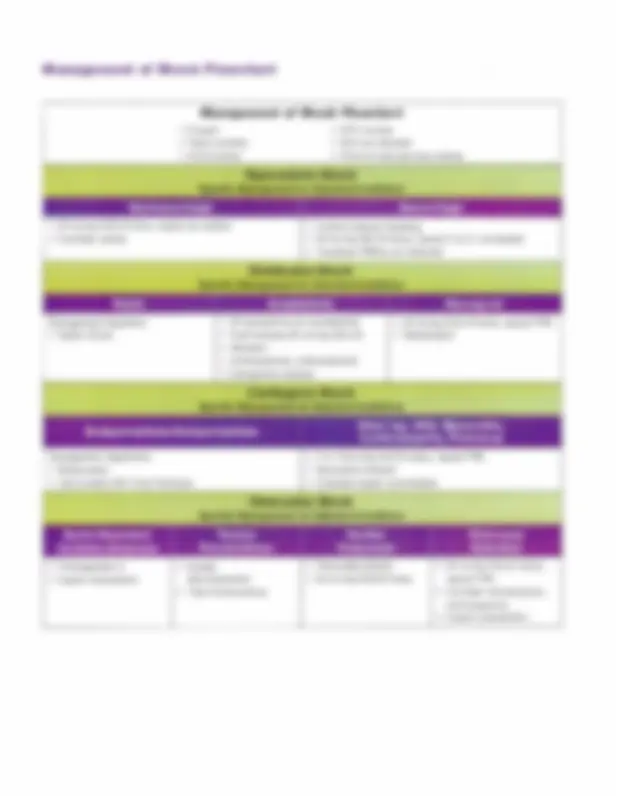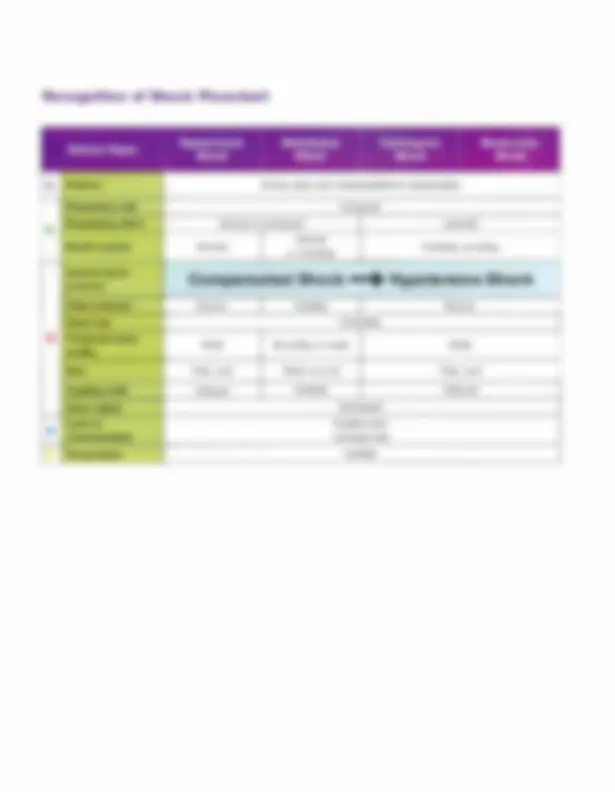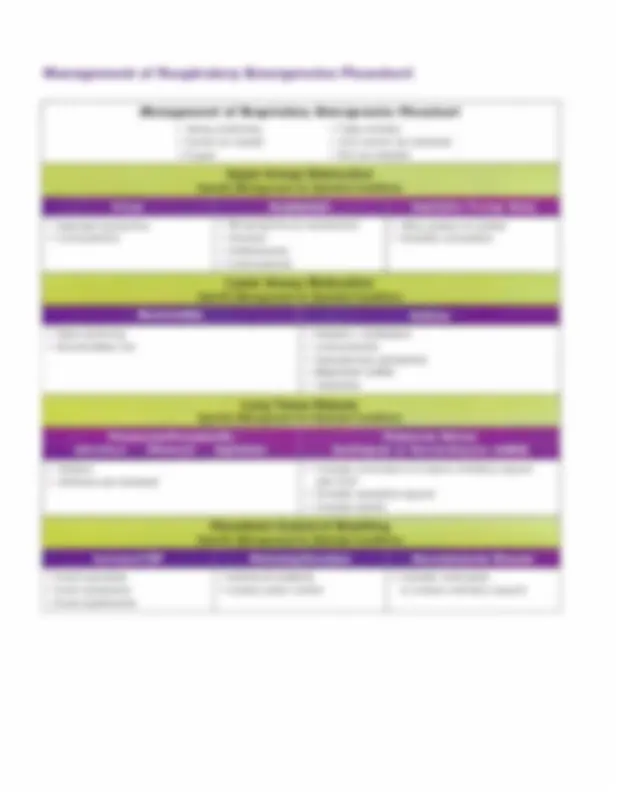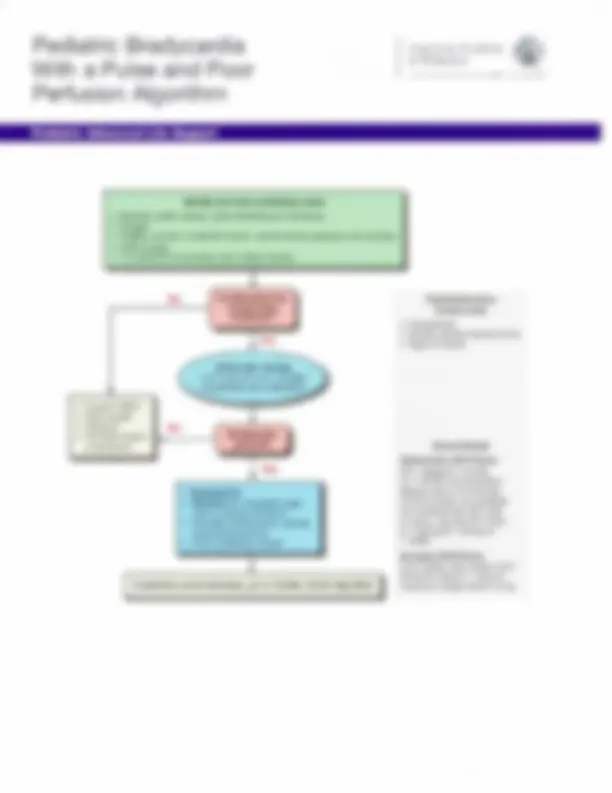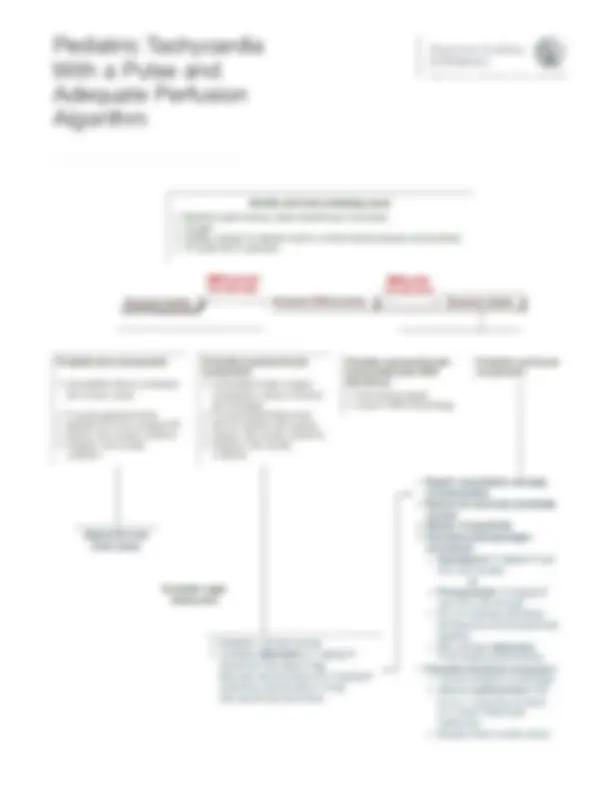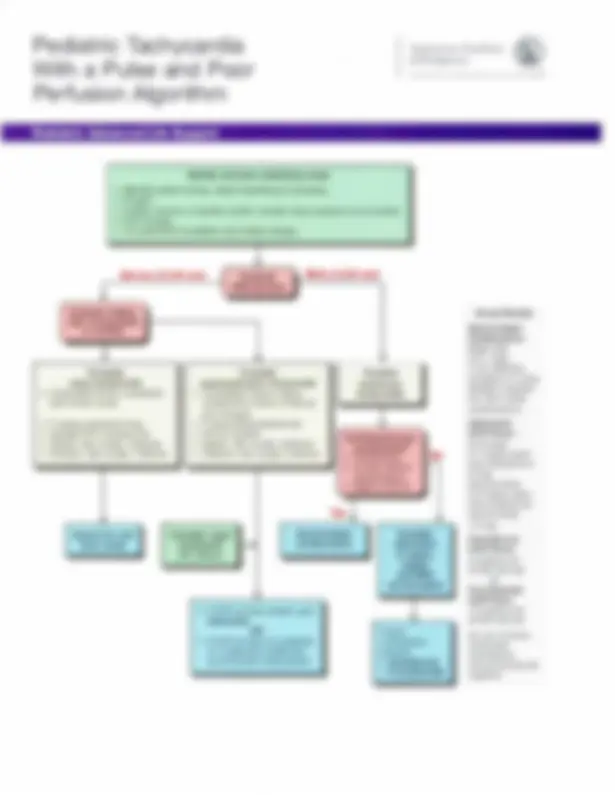Download PALS Algorithms Cheat Sheet and Flow Chart and more Cheat Sheet Pediatrics in PDF only on Docsity!
PALS
Algorithms
1. PALS Systematic Approach Algorithm
2. Management of Shock Flowchart
3. Recognition of Shock Flowchart
4. Management of Respiratory Emergencies
Flowchart
5. Recognition of Respiratory Problems Flowchart
6. Pediatric Cardiac Arrest Algorithm
7. Pediatric Bradycardia With a Pulse and
Poor Perfusion Algorithm
8. Pediatric Tachycardia With a Pulse and
Adequate Perfusion Algorithm
9. Pediatric Tachycardia With a Pulse and
Poor Perfusion Algorithm
10. Pediatric Postresuscitation Care
PALS Systematic Approach Algorithm
The PALS Systematic Approach Algorithm outlines the approach
to caring far a critically ili or injured child.
lnitial lmpression
(consciousness, breathing, color)
1s child unresponsive with no breathing or only gasping?
Yes
Shout for Help/
Activate Emergency Response
(as appropriate tor setting)
1s there a pulse?
Yes (^) Open airway and begin ventilation
No
Yes
Go to
Pediatrie Cardiac Arrest
Algorithm
After ROSC, begin
Evaluate-ldentify-lntervene
sequence (right column)
and oxygen as available
1s the pulse <60/min with
poor perfusion despite
oxygenation and ventilation?
lf at any time you identify cardlac arrest
No
No
Evaluate
- Primary assessment
- Secondary assessment
- Diagnostic tests
ldentify
Recognition of Shock Flowchart
Clinica! Signs
I
Hypovolemic
I
Distributive
I
Cardiogenic
I
Obstructive Shock Shock Shock Shock
A Patency^ Airway open and maintainable/not maintainable
Respiratory rate lncreased
B
Respiratory effort Normai to increased Labored
Breath sounds Normai
Normai Crackles, grunting (± crackles)
Systolic blood
pressure Compensated Shock^ ►^ Hypotensive Shock
Pulse pressure Narrow Variable Narrow
Heart rate lncreased
e Peripheral pulse quality
Weak Bounding or weak Weak
Skin Pale, cool Warm or cool Pale, cool
Capillary refill Delayed Variable^ Delayed
Urine output Decreased
D
Level of lrritable early consciousness Lethargic late
Temperature Variable
Management of Respiratory Emergencies Flowchart
Management of Respiratory Emergencies Flowchart
- Airway positioning • Pulse oximetry
- Suction as needed • ECG monitor (as indicateci)
- Oxygen • BLS as indicateci
Upper Airway Obstruction Specific Management far Selected Canditians
Croup I Anaphylaxis I Aspiration Foreign Body
- Nebulized epinephrine
- Corticosteroids
- IM epinephrine (or autoinjector) (^) • Allow position of comfort
- Albuterol • Specialty consultation
- Antihistamines
- Corticosteroids
Lower Airway Obstruction Specific Management far Selected Conditians
Bronchiolitis (^) I Asthma
- Nasal suctioning • Albuterol ± ipratropium
- Bronchodilator trial • Corticosteroids
- Subcutaneous epinephrine
- Magnesium sulfate
- Terbutaline
Lung Tissue Disease Specific Management far Selected Canditians
Pneumonia/Pneumonitis
I
Pulmonary Edema
lnfectious Chemical Aspiration Cardiogenic or Noncardiogenic (ARDS)
- Albuterol
- Antibiotics (as indicateci)
- Consider noninvasive or invasive ventilatory support
with PEEP
- Consider vasoactive support
- Consider diuretic
Disordered Control of Breathing Specific Management far Selected Canditians
lncreased ICP I Poisoning/Overdose I Neuromuscular Disease
- Avoid hypoxemia • Antidote (if available) • Consider noninvasive
- Avoid hypercarbia • Contact poison control or invasive ventilatory support
- Avoid hyperthermia
Pediatrie Cardiac
Arrest Algorithm
Pediatrie Advanced Life Support
Shout for Help/Activate Emergency Response
2
Yes
VFNT
3 t Shock
'f
Yes 5 ,.
Shock
Yes 7 ,. Shock
No
No
Start CPR
Rhythm shockable?
No
No
Asystole/PEA
CPR 2 min
IV access inephrine eve nsider advanc
Rhythm shockable?
No
CPR 2 min
Rhythm shockable?
12
- Asystole/PEA -+ 1 O or 11
- Organized rhythm -+ check pulse
- Pulse present (ROSC) -+ post-cardiac arrest care
Yes
Yes
Goto 5 or 7
American Academy of Pediatrics DEDICATED TO THE HEALTH OF ALL CHILDREN"
Doses/Details CPR Quality
- Push hard (�1/3 of anterior posterior diameter of chest) and fast (at least 100/min) and allow complete chest recoil
- Minimize interruptions in compressions
- Avoid excessive ventilation
- Rotate compressor every 2 minutes
- lf no advanced airway, 15:2 compression ventilation ratio. lf advanced airway, 8-1O breaths per minute with continuous chest compressions Shock Energy for. Defibrillation First shock 2 J/kg, second shock 4 J/kg, subsequent shocks �4 J/kg, maximum 1 O J/kg or adult dose. Drug Therapy
- Epinephrine IO/IV Dose: 0.01 mg/kg (0.1 mUkg of 1 :10 000 concentration). Repeat every 3-5 minutes. lf no IO/IV access, may give endotracheal dose: 0.1 mg/kg (0.1 mUkg of 1 : concentration).
- Amiodarone IO/IV Dose: 5 mg/kg bolus during cardiac arrest. May repeat up to 2 times for refractory VF/pulseless VT. Advanced Airway
- Endotracheal intubation or supraglottic advanced airway
- Waveform capnography or capnometry to confirm and monitor ET tube placement
- Once advanced airway in piace give 1 breath every 6-8 seconds (8-1O breaths per minute) Return of Spontaneous Circulation (ROSC)
- Pulse and blood pressure
- Spontaneous arteria! pressure waves with intra-arterial monitoring Reversible Causes
- Hypovolemia
- Hypoxia
- Hydrogen ion (acidosis)
- Hypoglycemia
- Hypo-/hyperkalemia
- Hypothermia
- Tension pneumothorax
- Tamponade, cardiac
- Toxins
- Thrombosis, pulmonary
- Thrombosis, coronary
Pediatrie Bradycardia
With a Pulse and Poor
Perfusion Algorithm
Pediatrie Advanced Lite Support
ldentify and treat underlying cause
- Maintain patent airway; assist breathing as necessary
- Oxygen
- Cardiac monitor to identify rhythm; monitor blood pressure and oximetry
- IO/IV access
- 12-Lead ECG if available; don't delay therapy
- Support ABCs
- Give oxygen
- Observe
- Consider expert consultation
No
No
Cardiopulmonary compromise continues?
Yes
Bradycardia persists?
**- Epinephrine
- Atropine** for increased vagai tone or primary AV block
- Consider transthoracic pacing/ transvenous pacing
- Treat underlying causes
lf pulseless arrest develops, go to Cardiac Arrest Algorithm I
American Academy
of Pediatrics
DEDICATED TO THE HEALTH OF ALL CHILOREN'"
Cardiopulmonary Compromise
- Hypotension
- Acutely altered menta! status
- Signs of shock
Doses/Details Epinephrine IO/IV Dose: 0.01 mg/kg (0.1 mUkg of 1 :1O 000 concentration). Repeat every 3-5 minutes. lf 1O/IV access not available but endotracheal (ET) tube in piace, may give ET dose: 0.1 mg/kg (0.1 mUkg of 1 :1000). Atropine 10/IV Dose: 0.02 mg/kg. May repeat once. Minimum dose 0.1 mg and maximum single dose 0.5 mg.
Pediatrie Tachycardia
With a Pulse and Poor
Perfusion Algorithm
American Academy of Pediatrics DEDICATED TO THE HEALTH OF ALL CHILDREN"'
Pediatrie Advanced Life Support
ldentify and treat underlying cause
- Maintain patent airway; assist breathing as necessary
- Oxygen
- Cardiac monitor to identify rhythm; monitor blood pressure and oximetry
- IO/IV access
- 12-Lead ECG if available; don't delay therapy
�------------I^ Narrow (:S0.09 sec)^ (^ Evaluate •^ Wide (>0.09 sec)
Evaluate rhythm with 12-lead ECG or monitor
Probable sinus tachycardia
- Compatible history consistent with known cause
- P waves present/normai
- Variable R-R; constant PR
- lnfants: rate usually <220/min
- Children: rate usually <180/min
Search for and treat cause
l QRS duration^ I
Probable supraventricular tachycardia
- Compatible history (vague, nonspecific); history of abrupt rate changes
- P waves absent/abnormal
- HR not variable
- lnfants: rate usually <!220/min
- Children: rate usually <!180/min
Possible ventricular tachycardia
Cardiopulmonary compromise?
- Hypotension
- Acutely altered mental status
- Signs of shock
No
Consider vagai maneuvers i-,. (No delays)
Synchronized cardioversion
Consider adenosine
- lf IO/IV access present, give adenosine OR
- lf IO/IV access not available, or if adenosine ineffective, synchronized cardioversion
if rhythm regular and QRS monomorphic
Expert consultation advised
**- Amiodarone
Doses/Details Synchronized Cardioversion: Begin with 0.5-1 J/kg; if not effective, increase to 2 J/kg. Sedate if needed, but don't delay cardioversion. Adenosine IO/IV Dose: First dose: 0.1 mg/kg rapid bolus (maximum: 6 mg). Second dose: 0.2 mg/kg rapid bolus (maximum second dose 12 mg). Amiodarone IO/IV Dose: 5 mg/kg over 20-60 minutes or Procainamide IO/IV Dose: 15 mg/kg over 30-60 minutes Do not routinely administer amiodarone and procainamide together.
Pediatrie
Postresuscitation Care
Pediatrie Advanced Life Support
Management of Shock After ROSC
Optimize Ventilation and Oxygenation
- Titrate FI0 2 to maintain oxyhemoglobin saturation 94%-99%; if possible, wean FI0 2 if saturation is 100%
- Consider advanced airway placement and waveform capnography
Assess for and Treat Persistent Shock
- ldentify, treat contributing factors.*
- Consider 20 mUkg IV/IO boluses of isotonic crystalloid. Consider smaller boluses (eg, 1 O mUkg) if poor cardiac function suspected.
- Consiqer the need for inotropic and/or vasopressor support for fluid-refractory shock.
*Possible Contributing Factors
Hypovolemia Hypoxia Hydrogen ion (acidosis) Hypoglycemia Hypo-/hyperkalemia Hypothermia Tension pneumothorax Tamponade, cardiac Toxins Thrombosis, pulmonary Thrombosis, coronary Trauma
Hypotensive Shock Normotensive Shock
- Epinephrine • Dobutamine
- Dopamine • Dopamine
- Norepinephrine • Epinephrine
I
l
- Monitor for and treat agitation and seizures
- Monitor for and treat hypoglycemia
- Assess blood gas, serum electrolytes, calcium
- lf patient remains comatose after resuscitation from cardiac arrest, consider therapeutic hypothermia (32°C-34 °C)
- Consider consultation and patient transport to tertiary care center
American Academy of Pediatrics DEDICATED TO THE HEALTH OF ALL CHILOREN"'
Estimation of Maintenance Fluid
Requirements
- lnfants <10 kg: 4 mUkg per hour Example: For an 8-kg infant, estimated maintenance fluid rate = 4 mUkg per hour x 8 kg = 32 ml per hour
- Children 10-20 kg: 4 mUkg per hour for the first 1 O kg + 2 mUkg per hour for each kg above 10 kg Example: For a 15-kg child, estimated maintenance fluid rate = (4 mUkg per hour x 1 O kg) + (2 mUkg per hour x 5 kg) = 40 mUhour + 1 O mUhour = 50 mUhour
- Children >20 kg: 4 mUkg per hour for the first 10 kg+ 2 mUkg per hour for kg 11-20 + 1 mUkg per hour for each kg above 20 kg. Example: For a 28-kg child, estimated maintenance fluid rate = (4 mUkg per hour x 1 O kg) + (2 mUkg per hour x 1 O kg) + (1 mUkg per hour x 8 kg) = 40 ml per hour + 20 ml per hour + 8 ml per hour = 68 ml per hour Following initial stabilization, adjust the rate and composition of intravenous fluids based on the patient's clinica! condition and state of hydration. In generai, provide a continuous infusion of a dextrose-containing solution for infants. Avoid hypotonic solutions in critically ili children; for most patients use isotonic fluid such as normai saline (0.9% NaCI) or lactated Ringer's solution with or without dextrose, based on the child's clinica! status.

